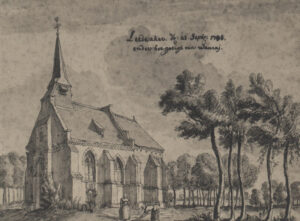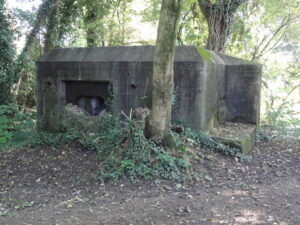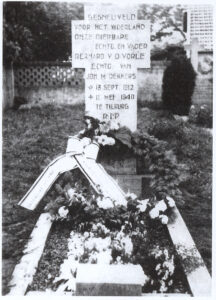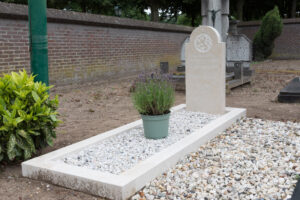Vorle, Bernardus Gerardus van de., born on 13-09-1912 in Ledeacker  as the second of the five children of Reinier van de Vorle and Paulina, born Peeters. Bernardus lives with his wife Johanna Dekkers and their children in the neighboring village of Sint Anthonis, where he also works as an upholsterer. When the threat of war for the Netherlands increased in the course of 1939, Ben was called into arms and assigned as a soldier to 2-II-2 Infantry Regiment and stationed in the Erp section of the Peel-Raamstelling. On 10-05-1940,
as the second of the five children of Reinier van de Vorle and Paulina, born Peeters. Bernardus lives with his wife Johanna Dekkers and their children in the neighboring village of Sint Anthonis, where he also works as an upholsterer. When the threat of war for the Netherlands increased in the course of 1939, Ben was called into arms and assigned as a soldier to 2-II-2 Infantry Regiment and stationed in the Erp section of the Peel-Raamstelling. On 10-05-1940,  the German army invaded the Netherlands and the national defenses along the Maas and the Peel-Raamstelling collapsed. The next day, Ben and his unit are ordered to march to the stage location Tilburg, where he arrives late in the afternoon. The Bredaseweg then became one of the most important arterial routes for the westward retreat and therefore came under heavy fire from German attack squadrons on May 11th. Ben is one of many victims killed in this attack. He is killed near the zoo. Ben turned 27 and found his final resting place at home in Sint Anthonis.
the German army invaded the Netherlands and the national defenses along the Maas and the Peel-Raamstelling collapsed. The next day, Ben and his unit are ordered to march to the stage location Tilburg, where he arrives late in the afternoon. The Bredaseweg then became one of the most important arterial routes for the westward retreat and therefore came under heavy fire from German attack squadrons on May 11th. Ben is one of many victims killed in this attack. He is killed near the zoo. Ben turned 27 and found his final resting place at home in Sint Anthonis.
Death and burial ground of Vorle, Bernardus Gerardus van de.



His sons don’t know much about their father. When father Ben van de Vorle died on 11-005-1940, his eldest son Rien was three years old. His daughter Elly was even younger. The youngest, Ben (named after his father), was born only three months after their father was killed. They have picked up their lives, the Van de Vorle children. All three have studied. Elly and Ben went into education and Rien became a municipal official. They are not stuck in the loss and pain. But the pain never went away. Ben van de Vorle was a nice guy. “A real village person.” That’s how his son Ben describes him. He played goalkeeper in the first team of the local football club. He was a member of the village archery club. D’n Doel, that club was called. Just a young guy. Married to Johanna Dekkers. Two children with the third on the way. Saddler by profession. First in his father’s company. Later independently in nearby Boekel. Tensions in Europe increased in the late 1930s. After Austria, Germany also annexed Czechoslovakia. Nazi gluttony knew no bounds. The world had let Germany have its way for a long time, but in the meantime World War II had broken out. The Netherlands wanted to remain neutral, just like in the First World War, but mobilized the army. Ben van de Vorle also had to appear. He was afraid. Nothing good could come from war. He was right. Faster and more drastic than he feared. On May 10, 1940, he was a soldier of the 2-II-2 Infantry Regiment in Erp in the Peel-Raamstelling. 
 This turned out to be untenable and the troops withdrew to Tilburg. The next day the unit came under heavy fire from German attack squadrons. Ben van de Vorle was among the men who did not survive the battle. He was killed at the age of 27 and was buried in Tilburg. Later he was reburied in Sint Anthonis. His children grew up fatherless. When we spoke to his sons Rien and Ben so many years later – Elly lives in a nursing home and unfortunately could not be there – they do not have many memories of their father. “Mother didn’t say much. We heard from father’s brother, our uncle Anton, also a saddler, that he was a real village boy. He had a clear place in his society. From him we heard the stories about father’s membership in the archery club. Grandpa was also a member.” They shot on Sunday. After high mass. As a boy, Rien was an arrow carrier, which means that he brought back the arrows he shot for a small fee. Rien and Ben van de Vorle are clear about this. They had a good childhood. After the death of her husband, Johanna van de Vorle-Dekkers returned to her parental home. She raised her children together with her parents and an unmarried sister. “We were lovingly welcomed,” say Rien and Ben. “In our childhood we were not aware of the loss. We didn’t know any better.” The Van de Vorle family was not poor either. Mother received a pension from the Ministry of Defense and the village community saw to it that she got what she was entitled to. That went far, as Rien only discovered much later. “I was working at the town hall and one day I was looking for something in the archives. Then I found correspondence between the then mayor and the Ministry of Defense about the amount of mother’s pension. That was far too low, argued Mayor Goossens. That had to go up. And so it happened. It characterizes the society in which we grew up.” “When we had children, they did not miss their grandfather Van de Vorle,” says Ben. “We didn’t have a hard time with it either. It was what it was. We have always remained down-to-earth and realistic about it. Mother too. Although she went to Remembrance Day every year and that was always a difficult day. She also attended meetings of the Association of Dutch Military War Victims.” Rien accompanied his mother every year. “That’s where she got comfort. There she found fellow sufferers, who sometimes became friends. They looked for support from each other, that’s what they did.” The Vorle’s mother did not live to be old. After an illness, she died in the late 1960s at the age of 60. Today, the Van de Vorles still go to Remembrance Day. “Because we have to reflect on it, remember what happened at the time and learn from it. There remains a certain anger in us about what happened in 1940-1945. The Germans attacked the Netherlands, a peace-loving neighbor, for no reason and enslaved it for years. We never come away from Remembrance Day with a good feeling. Our mother never went to Germany again. We still think about father often, even though we never knew him. One of us regularly goes to his grave. We keep it neatly maintained, but we are happy that the War Graves Foundation is taking over as a soldier’s grave. He deserves that. When we think of father, we think of the handsome guy he was, that he died so young and that he had so little
This turned out to be untenable and the troops withdrew to Tilburg. The next day the unit came under heavy fire from German attack squadrons. Ben van de Vorle was among the men who did not survive the battle. He was killed at the age of 27 and was buried in Tilburg. Later he was reburied in Sint Anthonis. His children grew up fatherless. When we spoke to his sons Rien and Ben so many years later – Elly lives in a nursing home and unfortunately could not be there – they do not have many memories of their father. “Mother didn’t say much. We heard from father’s brother, our uncle Anton, also a saddler, that he was a real village boy. He had a clear place in his society. From him we heard the stories about father’s membership in the archery club. Grandpa was also a member.” They shot on Sunday. After high mass. As a boy, Rien was an arrow carrier, which means that he brought back the arrows he shot for a small fee. Rien and Ben van de Vorle are clear about this. They had a good childhood. After the death of her husband, Johanna van de Vorle-Dekkers returned to her parental home. She raised her children together with her parents and an unmarried sister. “We were lovingly welcomed,” say Rien and Ben. “In our childhood we were not aware of the loss. We didn’t know any better.” The Van de Vorle family was not poor either. Mother received a pension from the Ministry of Defense and the village community saw to it that she got what she was entitled to. That went far, as Rien only discovered much later. “I was working at the town hall and one day I was looking for something in the archives. Then I found correspondence between the then mayor and the Ministry of Defense about the amount of mother’s pension. That was far too low, argued Mayor Goossens. That had to go up. And so it happened. It characterizes the society in which we grew up.” “When we had children, they did not miss their grandfather Van de Vorle,” says Ben. “We didn’t have a hard time with it either. It was what it was. We have always remained down-to-earth and realistic about it. Mother too. Although she went to Remembrance Day every year and that was always a difficult day. She also attended meetings of the Association of Dutch Military War Victims.” Rien accompanied his mother every year. “That’s where she got comfort. There she found fellow sufferers, who sometimes became friends. They looked for support from each other, that’s what they did.” The Vorle’s mother did not live to be old. After an illness, she died in the late 1960s at the age of 60. Today, the Van de Vorles still go to Remembrance Day. “Because we have to reflect on it, remember what happened at the time and learn from it. There remains a certain anger in us about what happened in 1940-1945. The Germans attacked the Netherlands, a peace-loving neighbor, for no reason and enslaved it for years. We never come away from Remembrance Day with a good feeling. Our mother never went to Germany again. We still think about father often, even though we never knew him. One of us regularly goes to his grave. We keep it neatly maintained, but we are happy that the War Graves Foundation is taking over as a soldier’s grave. He deserves that. When we think of father, we think of the handsome guy he was, that he died so young and that he had so little
Ben is scared. After all, nothing good can come from war. He’s right. He died on 11-05-1940 in Tilburg. Soldier Ben van de Vorle turned 27 years old. His wife Johanna stays behind with their children Rien and Elly, and is also pregnant with the third. She calls him Ben, after his father.To this day, the children visit the grave, the care of which we recently took over. His two sons say: “We often think about father, even though we never knew him. One of us regularly goes to his grave. We keep it neatly maintained, but we are happy that the War Graves Foundation is taking over as a soldier’s grave. He deserves that.”In this series of images you can see how we renovated Ben’s grave in Sint Anthonis step by step. The old gravestone has been replaced by the stone that you find on war graves throughout the country. Ben will rest in this place forever, together with his Johanna.



Message(s), tips or interesting graves for the webmaster: robhopmans@outlook.com















Leave a Reply